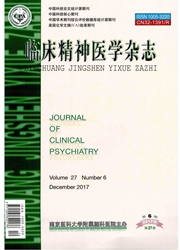

 中文摘要:
中文摘要:
目的:比较倒退型与非倒退型孤独障碍儿童的临床特征。方法:121例符合《美国精神障碍诊断和统计手册》第4版(修订版)孤独障碍诊断标准的2~5岁孤独障碍儿童,使用自编一般情况调查表调查患儿的一般情况及相关信息;采用贝利婴幼儿发展量表进行发育商测量;用儿童孤独症评定量表(CARS)评定孤独障碍严重程度;使用《倒退情况补充核查表》结合孤独症诊断访谈量表(修订本)根据起病形式分为倒退型和非倒退型两组,对比分析两组一般情况及临床特征。结果:121例孤独障碍儿童中倒退型30例(32.97%),孤独障碍儿童技能倒退起病的平均年龄为23.81个月。倒退型和非倒退型孤独障碍儿童的性别差异无统计学意义(χ2=2.97,P=0.09);发育商差异无统计学意义(t=1.04,P=0.30);CARS量表总分倒退型组显著高于非倒退型组(t=-2.47,P=0.02)。主要的倒退类型是语言、社交、语言合并社交。倒退型孤独障碍儿童其倒退时发生的前3位生活事件为:主要照管者的改变、生病、家庭冲突;在倒退型孤独障碍儿童中有73.33%的家长反映有技能重获,技能重获的相关事件为:行为训练(30.00%)和父母陪伴时间长(10.00%)。结论:孤独障碍儿童中约1/3在起病形式上属于倒退型。倒退型较非倒退型孤独障碍儿童的症状更严重,家庭环境及躯体疾病可能与其倒退发生有关。训练、父母陪伴有助于孤独障碍儿童技能丧失后的重获。
 英文摘要:
英文摘要:
Objective: To compare the developmental characteristic and clinical symptom of autistic children with regression and non-regression. Method:The children who met the autistic disorder criteria of A- merican diagnostic and statistical manual of mental disorders 4th edition (revised) were enrolled, and assessed using the general information, Bayley infant development scale and the childhood autism rating scale (CARS). Regression supplement form was administered and autism diagnostic interview-revised was conducted, and the enrolled children were divided into two groups (regressive type and non-regressive) based on the results. The developmental and clinical characteristics were compared between the groups. Results:Of 121 autistic chil- dren, there were 30 ( 32.97 % ) regression type children, whose mean onset age was 23.81 months. There was no significant difference in the proportion of male and female ( x^2 = 2.97, P = 0. 09 ) and development quotient ( t = 1.04, P = 0.30 ) between regressive and non regressive autistic children. Total score of CARS in the regressive group was significantly higher than the non regressive group ( t = 2. 47 ,P = 0.02 ). Major regressive types were language, social, and the combination of both. The first three life events in children with regressive autism when regression occurred were the changes of the primary caregivers,the children's illness and the family conflict. 73.33% of the regressive group reported regained skills ,and the related events were behavior training(30.00% ) and parents spend more time with children ( 10.00% ). Conclusion : There are approximately 1/3 autistic children with regression. Compared with the non regression autistic children, autistic children with regression demonstrate more severe symptoms. Their family environment and medical condition may be associated with their regression. Autism training and being accompanied by their parents will help them regain skills.
 同期刊论文项目
同期刊论文项目
 同项目期刊论文
同项目期刊论文
 期刊信息
期刊信息
